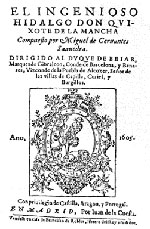|
 |
Home Page >
Textual pathway > The novel > I Promessi Sposi: literary models
 I Promessi Sposi: literary models I Promessi Sposi: literary models
 Careful investigation of the narrative sources of Fermo e Lucia and the Promessi Sposi has pointed to surprising references, citations, re-elaborations and influences from all of Europe’s important literature, and especially the novel tradition. The extent of French literary models is considerable, also on account of Manzoni’s linguistic, cultural and personal affinities with France. Included among the possible influences is Rousseau, whose preface to the Nouvelle Héloïse deals with the morally dangerous and disturbing nature of love novels, a theme also developed by Manzoni in the digression that precedes the story of Geltrude in his first draft. Another important French author is Diderot, whose Religieuse is a direct model for the chapters on the nun of Monza. Shakespeare too is remarkably and explicitly present in the novel: Manzoni had made his views on Shakespeare clear in his Lettre to Chauvet, and the influence of his plays on characters and situations in Manzoni’s novel is clear (for example, the figure of Father Cristoforo recalls Friar Laurence in Romeo and Juliette, with their similar roles as protectors of the young couple). Manzoni’s profound knowledge of German theatre is also discernible in his novel, and in particular Schiller, with influences from Die Jungfrau von Orleans (The Maid of Orleans, for Lucia’s Addio ai monti), Wilhelm Tell (William Tell), Don Karlos, Infant von Spanien (Don Carlos) and Die Räuber (The Robbers). Spain too, not only its chivalric customs, flowery language and grand-sounding names, but also its dramatists, the “Picaresque” novel and especially Cervantes. Don Quixote is undoubtedly one of the possible models for the Introduzione to the Promessi Sposi and the device of the “rediscovered manuscript”. Further textual similarities include the squabbles between Don Abbondio and Perpetua, which echo those between the knight and his squire Sancho Panza, and the grotesque rituals of chivalry ridiculed by Cervantes, which are reiterated in Lodovico’s duel scene in Chapter IV of the Promessi Sposi. Careful investigation of the narrative sources of Fermo e Lucia and the Promessi Sposi has pointed to surprising references, citations, re-elaborations and influences from all of Europe’s important literature, and especially the novel tradition. The extent of French literary models is considerable, also on account of Manzoni’s linguistic, cultural and personal affinities with France. Included among the possible influences is Rousseau, whose preface to the Nouvelle Héloïse deals with the morally dangerous and disturbing nature of love novels, a theme also developed by Manzoni in the digression that precedes the story of Geltrude in his first draft. Another important French author is Diderot, whose Religieuse is a direct model for the chapters on the nun of Monza. Shakespeare too is remarkably and explicitly present in the novel: Manzoni had made his views on Shakespeare clear in his Lettre to Chauvet, and the influence of his plays on characters and situations in Manzoni’s novel is clear (for example, the figure of Father Cristoforo recalls Friar Laurence in Romeo and Juliette, with their similar roles as protectors of the young couple). Manzoni’s profound knowledge of German theatre is also discernible in his novel, and in particular Schiller, with influences from Die Jungfrau von Orleans (The Maid of Orleans, for Lucia’s Addio ai monti), Wilhelm Tell (William Tell), Don Karlos, Infant von Spanien (Don Carlos) and Die Räuber (The Robbers). Spain too, not only its chivalric customs, flowery language and grand-sounding names, but also its dramatists, the “Picaresque” novel and especially Cervantes. Don Quixote is undoubtedly one of the possible models for the Introduzione to the Promessi Sposi and the device of the “rediscovered manuscript”. Further textual similarities include the squabbles between Don Abbondio and Perpetua, which echo those between the knight and his squire Sancho Panza, and the grotesque rituals of chivalry ridiculed by Cervantes, which are reiterated in Lodovico’s duel scene in Chapter IV of the Promessi Sposi.
 
|
|
 |
 |
 |
 |
 |
 |
 |
 |
     |
